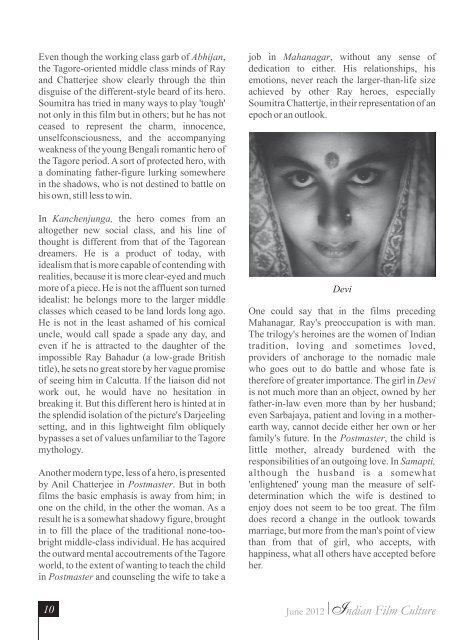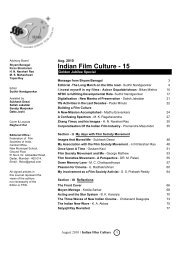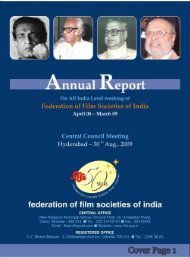Indian Film Culture - 16.cdr - federation of film societies of india
Indian Film Culture - 16.cdr - federation of film societies of india
Indian Film Culture - 16.cdr - federation of film societies of india
You also want an ePaper? Increase the reach of your titles
YUMPU automatically turns print PDFs into web optimized ePapers that Google loves.
Even though the working class garb <strong>of</strong> Abhijan,<br />
the Tagore-oriented middle class minds <strong>of</strong> Ray<br />
and Chatterjee show clearly through the thin<br />
disguise <strong>of</strong> the different-style beard <strong>of</strong> its hero.<br />
Soumitra has tried in many ways to play 'tough'<br />
not only in this <strong>film</strong> but in others; but he has not<br />
ceased to represent the charm, innocence,<br />
unselfconsciousness, and the accompanying<br />
weakness <strong>of</strong> the young Bengali romantic hero <strong>of</strong><br />
the Tagore period. A sort <strong>of</strong> protected hero, with<br />
a dominating father-figure lurking somewhere<br />
in the shadows, who is not destined to battle on<br />
his own, still less to win.<br />
In Kanchenjunga, the hero comes from an<br />
altogether new social class, and his line <strong>of</strong><br />
thought is different from that <strong>of</strong> the Tagorean<br />
dreamers. He is a product <strong>of</strong> today, with<br />
idealism that is more capable <strong>of</strong> contending with<br />
realities, because it is more clear-eyed and much<br />
more <strong>of</strong> a piece. He is not the affluent son turned<br />
idealist: he belongs more to the larger middle<br />
classes which ceased to be land lords long ago.<br />
He is not in the least ashamed <strong>of</strong> his comical<br />
uncle, would call spade a spade any day, and<br />
even if he is attracted to the daughter <strong>of</strong> the<br />
impossible Ray Bahadur (a low-grade British<br />
title), he sets no great store by her vague promise<br />
<strong>of</strong> seeing him in Calcutta. If the liaison did not<br />
work out, he would have no hesitation in<br />
breaking it. But this different hero is hinted at in<br />
the splendid isolation <strong>of</strong> the picture's Darjeeling<br />
setting, and in this lightweight <strong>film</strong> obliquely<br />
bypasses a set <strong>of</strong> values unfamiliar to the Tagore<br />
mythology.<br />
Another modern type, less <strong>of</strong> a hero, is presented<br />
by Anil Chatterjee in Postmaster. But in both<br />
<strong>film</strong>s the basic emphasis is away from him; in<br />
one on the child, in the other the woman. As a<br />
result he is a somewhat shadowy figure, brought<br />
in to fill the place <strong>of</strong> the traditional none-toobright<br />
middle-class individual. He has acquired<br />
the outward mental accoutrements <strong>of</strong> the Tagore<br />
world, to the extent <strong>of</strong> wanting to teach the child<br />
in Postmaster and counseling the wife to take a<br />
10<br />
job in Mahanagar, without any sense <strong>of</strong><br />
dedication to either. His relationships, his<br />
emotions, never reach the larger-than-life size<br />
achieved by other Ray heroes, especially<br />
Soumitra Chattertje, in their representation <strong>of</strong> an<br />
epoch or an outlook.<br />
Devi<br />
One could say that in the <strong>film</strong>s preceding<br />
Mahanagar, Ray's preoccupation is with man.<br />
The trilogy's heroines are the women <strong>of</strong> <strong>Indian</strong><br />
tradition, loving and sometimes loved,<br />
providers <strong>of</strong> anchorage to the nomadic male<br />
who goes out to do battle and whose fate is<br />
therefore <strong>of</strong> greater importance. The girl in Devi<br />
is not much more than an object, owned by her<br />
father-in-law even more than by her husband;<br />
even Sarbajaya, patient and loving in a motherearth<br />
way, cannot decide either her own or her<br />
family's future. In the Postmaster, the child is<br />
little mother, already burdened with the<br />
responsibilities <strong>of</strong> an outgoing love. In Samapti,<br />
although the husband is a somewhat<br />
'enlightened' young man the measure <strong>of</strong> selfdetermination<br />
which the wife is destined to<br />
enjoy does not seem to be too great. The <strong>film</strong><br />
does record a change in the outlook towards<br />
marriage, but more from the man's point <strong>of</strong> view<br />
than from that <strong>of</strong> girl, who accepts, with<br />
happiness, what all others have accepted before<br />
her.<br />
June 2012<br />
<strong>Indian</strong> <strong>Film</strong> <strong>Culture</strong>





